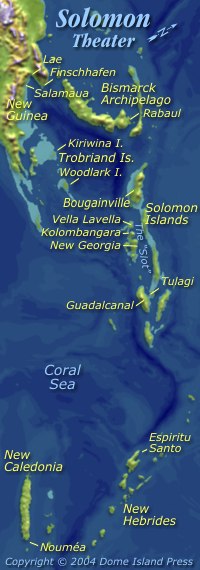In fact, we were. Command responsibilities between Admiral Halsey and General MacArthur had to be hammered out. Halsey recommended that he be allowed to make an assault on Munda (the airfield on the northern end of New Georgia Island) in April, but MacArthur had plans for New Guinea and asked that Halsey’s plan be delayed until he had established an airfield in the Trobriand Islands.

On 29 March 1943 a new directive was issued which was oriented toward the capture of Rabaul. Tasks and command relationships were set forth as follows:
“Operations are to be conducted under the direction of the Supreme Commander, Southwest Pacific Area (MacArthur).
“Operations in the Solomon Islands are to be under the direct command of Commander South Pacific Area (Halsey), operating under general directives from General MacArthur.
“Ships, planes and ground forces of the Pacific Fleet and Area, unless assigned by the joint Chiefs to task forces engaged in the above operations, are to remain under the control of the Commander in Chief Pacific Ocean Areas (Admiral Nimitz).”
“Establish airfields on Kiriwina and Woodlark Islands.
“Sieze Lae, Salamaua, Finschhafen, the Madang area and occupy western New Britain.
“Sieze and occupy Solomon Islands to include the southern portion of Bougainville.”
By this directive, Halsey retained tactical control all the way up the “Slot.” Nimitz continued to allot fleet units subject only to Joint Chiefs of Staff rulings.
(Since you may remember the bitterness toward General MacArthur that was commonplace at the time, it may be well to pause here for a quote which Morison attributes to Admiral Halsey. In part, it goes like this: “I have seldom seen a man who makes a quicker, stronger, more favorable impression . . . The respect that I conceived for him that afternoon grew steadily during the war . . . I can recall no flaw in our relationship . . . .” You can see that the top echelons of US Command in the South Pacific had established a reasonable working relationship.)
Halsey and MacArthur set 15 May as the date for invading New Georgia and the Tobriands. The operations was delayed six weeks because of delays in building up the amphibious force—thus we arrived at a date in early July for the landings at Rice Anchorage on New Georgia Island.
The Japanese organization to provide broad planning and direction in the face of this and increasingly worse adversity was not very effective. Each of the two services (Army and Navy) were distinct even in the Imperial Headquarters. The top five or six war lords of the Imperial Headquarters met two or three times a week in a room in the Imperial Palace, but the actual decisions were made by each service acting separately. The Emperor, although a mere figurehead, was given accurate reports, but none of his advisors were permitted to know what was going on or to have short wave radios to catch foreign broadcasts. No members of the Diet toured the war zones and questioned expenditures or strategy. No roving reporters informed the public and cultivated armchair strategies.
The evacuation of Guadalcanal was a serious loss of face for the Japanese. General Tojo promised the Emperor that the Japanese would strike back to crush the US forces that had stopped the Japanese offensive in the Solomon Islands and New Guinea areas. It was explained that this meant building up the bases at Munda and Kolombangara from which to inflict heavy damage by air strikes on US forces on Guadalcanal. Thus was born the so-called “I-go” or “I” offensive.
Starting in February and March of 1943, the Japanese made strenuous efforts to concentrate forces in the Solomons and New Guinea areas.
Submarines were recalled from as far away as the Indian Ocean and the Fiji Islands. By the end of March 1943 five submarines (RO-34, RO-100, RO-101, RO-102 and RO-103) were operating in the Guadalcanal area. The RO-34 joined the I-177 and I-180 in operations in the Slot between New Georgia and Santa Isabel Islands in an effort to intercept the US cruiser task forces which were operating at night in this area. By the latter part of April the RO-100, RO-103, RO-106 and RO-107 had been sent to intercept traffic in the San Cristobal area and the RO-101 and RO-102 had been sent to New Guinea. In late June the San Cristobal submarines were moved up the Slot to the Rendova area. The Japanese submarines encountered fierce opposition in some areas. By the end of July, the RO-34, RO-102, RO-103 and RO-107 had been lost and the RO-101 had been damaged by depth charge attack near Rice Anchorage.
(Did you know that some of the Japanese submarines carried their own aircraft and periodically conducted reconnaissance over areas we considered relatively safe—such as Espiritu Santo?)
The Japanese also identified destroyer operations to reenforce and resupply the Japanese ground forces on the islands northwest of Guadalcanal. The high speed night runs by destroyers—the old “Tokyo Express” of Guadalcanal—now became known as the “Vila Express.” The Vila Express generally was made up of two or more destroyers routed through the Slot or through Vella Gulf and Blackett Strait to offload supplies and troops as reinforcements for the Japanese forces in the Kula Gulf and similar areas. This type of operation provoked a great many battles—mostly between surface ships at night—which indelibly stamped the minds of many an old sailor with memories which forever remain his alone. By the end of the Central Solomons campaign, the Japanese had lost over forty destroyers—most associated with these night actions.